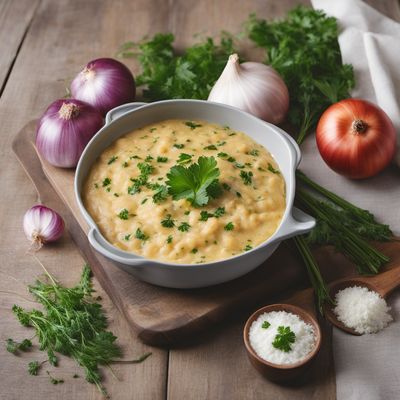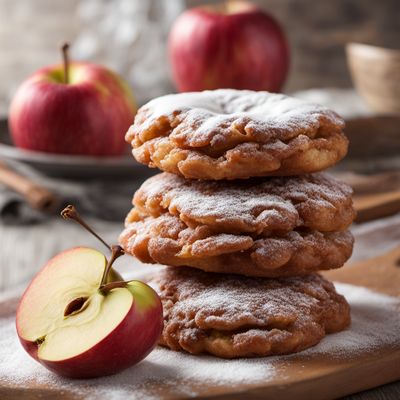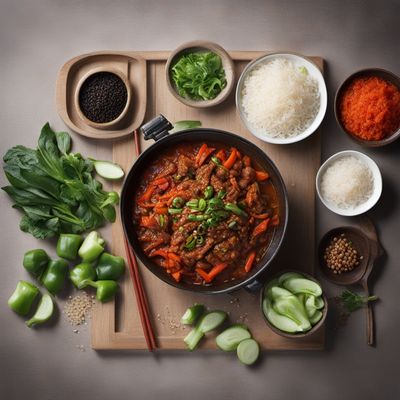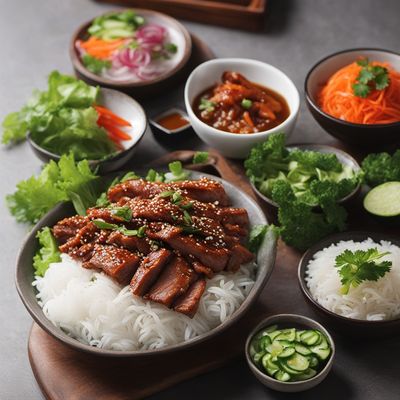
Recipe
Käsekrainer with a Korean Chinese Twist
Kimchi-infused Käsekrainer: A Fusion of Austrian and Korean Chinese Flavors
4.5 out of 5
This recipe combines the traditional Austrian dish Käsekrainer with the bold and vibrant flavors of Korean Chinese cuisine. The result is a delicious fusion that will tantalize your taste buds with its unique combination of smoky sausage and spicy kimchi.
Metadata
Preparation time
15 minutes
Cooking time
10 minutes
Total time
25 minutes
Yields
4 servings
Preparation difficulty
Easy
Suitable for
Omnivore, Gluten-free, Dairy-free (if using dairy-free Käsekrainer), Nut-free, Low-carb (if served without rice or noodles)
Allergens
Dairy (if using regular Käsekrainer), Soy (in soy sauce)
Not suitable for
Vegetarian, Vegan, Kosher, Halal, Paleo
Ingredients
In this Korean Chinese adaptation of Käsekrainer, the traditional Austrian sausage is paired with spicy and tangy kimchi, adding a unique twist to the dish. The flavors are enhanced by the addition of Korean Chinese spices and cooking techniques, resulting in a fusion dish that combines the best of both cuisines. We alse have the original recipe for Käsekrainer, so you can check it out.
-
4 Käsekrainer sausages 4 Käsekrainer sausages
-
1 cup (235ml) kimchi 1 cup (235ml) kimchi
-
1 tablespoon vegetable oil 1 tablespoon vegetable oil
-
1 teaspoon gochugaru (Korean red pepper flakes) 1 teaspoon gochugaru (Korean red pepper flakes)
-
1 teaspoon soy sauce 1 teaspoon soy sauce
-
1 teaspoon sesame oil 1 teaspoon sesame oil
-
1 teaspoon sugar 1 teaspoon sugar
-
Steamed rice or noodles, for serving Steamed rice or noodles, for serving
Nutrition
- Calories (kcal / KJ): 350 kcal / 1465 KJ
- Fat (total, saturated): 25g, 9g
- Carbohydrates (total, sugars): 10g, 3g
- Protein: 20g
- Fiber: 2g
- Salt: 2g
Preparation
-
1.Preheat a grill or grill pan over medium heat.
-
2.In a small bowl, mix together the gochugaru, soy sauce, sesame oil, and sugar to create a marinade.
-
3.Brush the Käsekrainer sausages with the marinade, ensuring they are evenly coated.
-
4.Grill the sausages for 8-10 minutes, turning occasionally, until they are cooked through and have grill marks.
-
5.While the sausages are grilling, heat the vegetable oil in a skillet over medium heat.
-
6.Add the kimchi to the skillet and sauté for 3-4 minutes, until it is heated through.
-
7.Serve the grilled Käsekrainer sausages with a generous portion of sautéed kimchi and steamed rice or noodles.
Treat your ingredients with care...
- Käsekrainer — Make sure to choose high-quality Käsekrainer sausages with a good balance of smoky flavor and cheese filling.
- Kimchi — Opt for a spicy and tangy kimchi for the best flavor. If you prefer less spiciness, you can rinse the kimchi before sautéing it.
Tips & Tricks
- If you can't find Käsekrainer sausages, you can substitute with regular smoked sausages and add a slice of cheese inside each sausage before grilling.
- Adjust the amount of gochugaru (Korean red pepper flakes) according to your spice preference.
- Serve the Kimchi-infused Käsekrainer with a side of pickled vegetables for added crunch and tanginess.
- For a milder version, you can serve the sausages with a dollop of sour cream or yogurt to balance the spiciness.
Serving advice
Serve the Kimchi-infused Käsekrainer hot off the grill, accompanied by a generous portion of sautéed kimchi and steamed rice or noodles. Garnish with chopped green onions for a fresh and vibrant touch.
Presentation advice
Arrange the grilled Käsekrainer sausages on a platter, placing the sautéed kimchi alongside them. Sprinkle some sesame seeds and chopped green onions over the dish for added visual appeal. Serve with a side of steamed rice or noodles in a separate bowl.
More recipes...
For Käsekrainer
For Austrian cuisine » Browse all
More Austrian cuisine dishes » Browse all

Wiener Saftgulasch
Viennese gravy goulash
Wiener Saftgulasch is a traditional Austrian beef stew that is perfect for cold weather.

Beuschel
Beuschel is a traditional Austrian dish that is made with veal lungs and heart. It is a hearty and flavorful meal that is perfect for cold weather.

Erdäpfelnidei
Erdapfelnidei
Erdäpfelnidei is a traditional Austrian dish that is similar to Italian gnocchi. It is a type of dumpling that is made from potatoes, flour, and...









